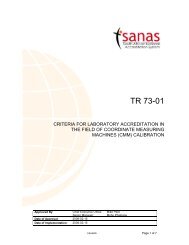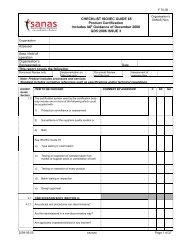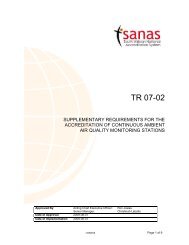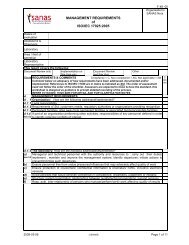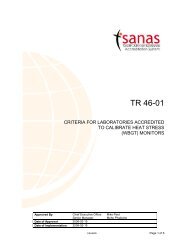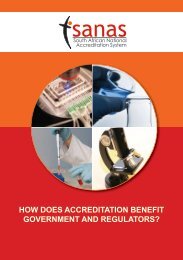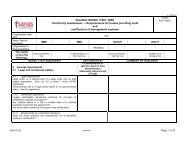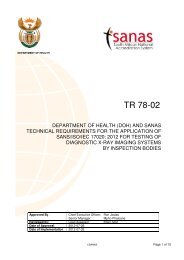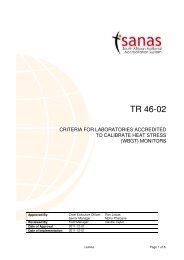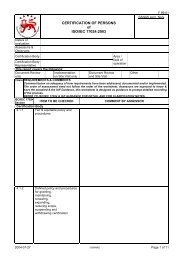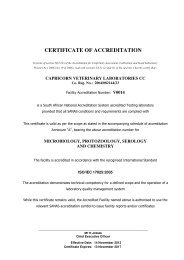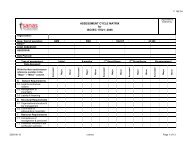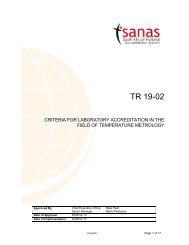TR 44-01 - Sanas
TR 44-01 - Sanas
TR 44-01 - Sanas
Create successful ePaper yourself
Turn your PDF publications into a flip-book with our unique Google optimized e-Paper software.
<strong>TR</strong> <strong>44</strong>-<strong>01</strong>CONTENTS:1. Purpose and Scope2. Definitions and References3. Abbreviations4. Environmental Requirements5. General Requirements6. Technical Requirements7. The Accreditation ScheduleAPPENDIX 1.ADDENDUM 1.Example of Accreditation ScheduleAmendment Record©SANAS Page 2 of 7
<strong>TR</strong> <strong>44</strong>-<strong>01</strong>1. Purpose and ScopeThe purpose of this document is to define the specific environmental, general and technicalrequirements to be met by accredited laboratories in the field humidity measurement and calibration.This document is applicable to South African National Accreditation System (SANAS) AccreditedLaboratories in this field.2. Definitions and ReferencesReferences[1] OHS Act, 1993 Environmental Regulations 1987 - Lighting[2] OHS Act, 1993 General Admin Regulations 1994 – Handling of HazardousChemical Substances[3] NPL, UK 1996 A Guide to the Measurement of HumidityIssued by the NPL and Institute of Measurement and ControlISBN 0-90<strong>44</strong>57-24-9[4] VIM International Vocabulary of Basic and General Terms in Metrology,BIPM, IEC, IFCC, ISO, IUPAC, OIML, 1993.DefinitionsAbsolute HumidityThe mass of water vapour present in a unit volume of moist air of a given temperature andpressure. SI (metric) units are grams of water per cubic metre of air (g.m -3 ). [3]• Dew PointThe temperature at which dew, or condensation forms, on cooling a gas. This is in effect thetemperature at which air becomes saturated in equilibrium with water, expressed in degreesCelsius (ºC) or occasionally other units of temperature.[3]• Response TimeTime interval between the instant when a stimulus is subjected to a specified abrupt change andthe instant when the response reaches and remains within specified limits around its finalsteady value.[4]RepeatabilityThe ability of a measuring instrument to provide closely similar indications for repeatedapplications of the same measurands under the same conditions of measurement. [4]• Relative HumidityRelative humidity is the ratio of the amount of water vapour, e, in the air to the amount of watervapour, e s , that would be in the air if saturated at the same temperature and pressure, and canbe expressedrelative humidity (in %) = e/e s X 100Where e is the water vapour pressure, and e s is the saturation vapour pressure of the prevailingambient temperature [3]• Saturation Vapour PressureMaximum pressure of water vapour that can exist at a given temperature. Expressed in units ofpressure e.g. in pascals (Pa) or in non-SI units such as millibars (mbar) or millimeteres ofmercury (mm Hg). [3]• Water Activity (of a substance)Water activity (a w ) is the relative humidity which is eventually reached in a closed space where ahygroscopic substance, such as a foodstuff, has been placed. It is the same as equilibriumrelative humidity except that it is expressed on a scale of 0 to 1 (no units) [3]©SANAS Page 3 of 7
<strong>TR</strong> <strong>44</strong>-<strong>01</strong>• Water Vapour PressureThat part of the total pressure contributed by the water vapour. Expressed in units ofpressure e.g. pascals (Pa). [3]3. Abbreviationsa wwater activityBMCBest Measurement CapabilityMSDS Material Safety Data SheetsrhRelative HumiditySANAS South African National Accreditation System4. Environmental RequirementsSignificant changes in relative humidity may occur with even slight variations in temperature and withoutchange in absolute humidity. For example, a 1ºC variance in temperature at 20ºC and 50% rh canintroduce an error of ± 3,2 %rh.[3].Therfore an accredited laboratory working in the field of humidity measurements shall operate under thefollowing environmental conditions:4.1 The laboratory should be maintained at a temperature of 23 ° C ± 3 ° C. Where measurements areperformed outside this specified requirement, the laboratory must ensure that appropriatecorrections are applied.4.2 Rates of change and gradients of the ambient temperature and humidity must be kept to below1 deg C per hour, and 10% rh per hour.4.3 A high degree of cleanliness shall be maintained in the laboratory and adequate lighting shall beprovided.[1]4.4 Localized isolation in the form of chambers, cabinets and enclosures may be utilized in order tominimize the effects of thermal currents and temperature gradients and in so doing provide astable and homogeneous environment conducive to reduced measurement uncertainties.4.5 The laboratory shall consider and include the stability of the environmental conditions on therelative humidity when estimating the uncertainty of measurement.5. General Requirements5.1 Laboratories operating in the field of humidity may be accredited for the calibration ofdewpoint hygrometers, relative humidity hygrometers, humidity generators, water activitymeters, saturated and unsaturated salt solutions, environmental chambers, and limitedtemperature calibration.(Refer to the Schedule of Accreditation – Appendix 1)5.2 Laboratories performing the calibration of the temperature indicating or recording component ofthermo-hygrometers or thermo-hygrographs respectively are limited to a BMC of ±1 ºC andrange of 15 to 50ºC, unless the laboratory is accredited as a temperature calibration laboratory.5.3 The laboratory will measure and report the measured value in the units applicable for eachspecific parameter. Generally, the units will be °C ( dew point), °C (frost point), %rh relativehumidity, a w (water activity).6. Technical Requirements6.1 The laboratory is required to have MSDS for all standards fluids, and chemicals, includingsaturated and unsaturated salt solutions, and cleaning materials used within the laboratory.[2]6.2 The laboratory is required to have procedures in place for the storage and usage of standards inorder to ensure their ongoing integrity.©SANAS Page 4 of 7
<strong>TR</strong> <strong>44</strong>-<strong>01</strong>6.3 The laboratory shall have and apply procedures for all calibrations.6.4 The laboratory shall have the necessary standards and equipment required to perform thecalibration measurements in accordance with their accreditation schedule.6.5 All measurements shall be taken only after adequate stabilization time. This period shall beaddressed in the calibration procedures, taking in to account possible differences in responsetime due to different time constants of the reference standard and the hygrometers or saltsolutions under test.6.6 The calibration of environmental and climatic chambers requires the availability of suitableinstrumentation capable of data storage. Laboratory procedures shall address the number oftemperature and relative humidity sensors required, and the spatial distribution thereof, and thisshall be dependant on the volume of the chamber. Guidance may be obtained from IEC 68-2-66:1994 ‘Environmental testing’. The calibration procedure shall address the time period overwhich the measurements are to be performed6.7 It is recommended that the humidity be measured at each point in the chamber where thetemperature is measured. The application of corrections based on spatial temperaturemeasurements, will result in humidity values with a larger uncertainty.6.8 Laboratories should take cognisance of effects of barometric pressure on humiditymeasurements6.9 Laboratories shall record and report the temperature at which the measurement of water activityor relative humidity has been made.7. The Accreditation ScheduleThe accreditation schedule shall follow the following format; the functions will be determined by thelaboratory application, ranges and uncertainties are approximate.See Appendix 1©SANAS Page 5 of 7
<strong>TR</strong> <strong>44</strong>-<strong>01</strong>APPENDIX 1.S C H E D U L E O F A C C R E D I T A T I O NPermanent Address of Laboratory:SuperLab25 Popular StreetTree ParkPort Southern AfricaPostal Address:P O Box 22222Port Southern AfricaX000Tel : (055) 321-4567Fax : (055) 321-6789E-mail: dolittle@mweb.co.zaTechnical SignatoriesNominated RepresentativeIssue No.Date of issueExpiry date: Dr I. DolittleMr D Green: Mrs M Brown: <strong>01</strong>: October 200X: October 200XITEM FUNCTION NOMINAL RANGE1 Dew-point Hygrometer - 75 ºC to - 60 ºC- 60 ºC to 17 ºCBEST MEASUREMENTCAPABILITIES EXPRESSEDAS AN UNCERTAINTY (±)0,4 + (0,073* │t + 60│) °C0,4 °C2 Salt Solution: Saturated & unsaturated15 °C to 30 °C(note the rh may also be expressed as arange)3 Digital Hygrometers /Thermo hygrometers15 °C to 30 °C0 % rh11 % rh33 % rh53 % rh75 % rh90 % rh95 % rh10 to 90 % rh15 ºC to 50 ºC2 % rh2 % rh2 % rh2 % rh2 % rh2 % rh2 % rh2 % rh1ºC4 Analogue RH Indicators 10 to 90 % rh 5 % rh5 Humidity RecordersThermo-Hygrograph6 Water Activitytest reportsData Loggers10 % rh to 90 % rh15 ºC to 50 ºC10 % rh to 90 % rh15 ºC to 50 ºC0,100 a w to 0,750 a w0,750 a w to 0,950 a w5 % rh1ºC3 % rh1ºC0,020 a w0,025 a w7 Environmental Chambers 5 % rh to 95 % rh 4 % rh8 On-Site calibration of item 7Page 1 of 1©SANAS Page 6 of 7
<strong>TR</strong> <strong>44</strong>-<strong>01</strong>ADDENDUM 1.AMENDMENT RECORDProposed By: Section ChangeFMChanged from a R <strong>44</strong> (Requirement) to a <strong>TR</strong> <strong>44</strong> (Technical Requirement)document.CEO Page 1 Changed to new logo & Front page©SANAS Page 7 of 7



